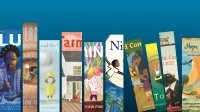10 Remarkable Recent Picture Books
These diverse picture books for preschool through grade 3, including three nonfiction selections, are sure to appeal to young students.
Your content has been saved!
Go to My Saved Content.One of my most favorite formats in the world of children’s literature is the picture book. Picture books are wonderful for many reasons, including their beautiful illustrations, succinct and powerful storytelling, and overall versatility in the classroom.
Their target audience is typically 4- to 8-year-olds, but as many educators can confirm, picture books can help teach concepts and skills across grade levels and subject areas.
As a K–8 librarian, I often read through the publications that review new children’s literature, and I’m astounded by the sheer quantity of great picture books that are published regularly. It can be tough to keep up.
Accordingly, I’ve put together a list of 10 diverse picture books that have been published in the last year or so. If you’re looking to incorporate some exciting new books into your teaching, then I’m hopeful you’ll find this list helpful. For each book, I’ve included a brief summary as well as a few suggestions for how you might use the book in your classroom.
10 Fantastic Recent Picture Books
Who’s Looking? How Animals See the World, by Carol Matas, illustrated by Cornelia Li (nonfiction): An engaging science-based book that includes short, fascinating narratives about—and images of—how different animals see the world. Use this in any elementary school science unit in which students study animals. Or you could play with the idea of “seeing” and use it to launch a discussion about the different ways that humans experience the world. (Pre-K to kindergarten)
Out of a Jar, by Deborah Marcero (fiction): Social and emotional learning–themed books are in high demand right now, and this is the best book I’ve read about managing emotions. Use it wherever and whenever you need a story that will spark discussions about how and why we should allow ourselves to fully feel our feelings. (Pre-K to grade 2)
I’ll Go and Come Back, by Rajani LaRocca, illustrated by Sara Palacios (fiction): This is a warm, vivid intergenerational love story. Use it to explore with your students how love is powerful enough to transcend culture and language. Use it to launch a personal narrative assignment about beloved grandparents or elders. Or use it as a mentor text to teach story structure and how to effectively use dual settings. (Pre-K to grade 2)
Mina, by Matthew Forsythe (fiction): This book is funny, clever, and surprising. You could use it to teach the elements of fiction: plot, characterization, point of view, tone, etc. It’s also a great model for creating tension between the text and image in an illustrated story. (Pre-K to grade 3)
Farmhouse, by Sophie Blackall (fiction): A gorgeous, fictionalized narrative about a real family, told in flowing, poetic language. This would be a great book to use at the beginning of a storytelling unit or project, as it illustrates the importance of each of us sharing our stories with the world. Be sure to read the back matter, too. (Pre-K to grade 3)
Lizzy and the Cloud, by Terry Fan and Eric Fan (fiction): This gentle story is full of heart and whimsy. After reading it, you could have a discussion with your students about what it really means to care for something or someone. You might also use it to explore with young children or teens the complex idea of how love often involves letting go. (Pre-K to grade 3)
The Three Billy Goats Gruff, by Mac Barnett, illustrated by Jon Klassen (fiction): An outrageously silly new book from zany duo Barnett and Klassen. This one could serve as a great primer for young writers on how to make an old or familiar story feel fresh and alive. You might also use it to show how students could effectively use more difficult literary tools like rhyme, tension, and humor. (Pre-K to grade 3)
Nigel and the Moon, by Antwan Eady, illustrated by Gracey Zhang (fiction): An inspiring, hopeful book about belonging and self-acceptance. Try using this one to launch a discussion with kids about their dreams: what kind of person they’d love to become and how they might take their first steps toward becoming that person. (Kindergarten to grade 3)
Blue: A History of the Color as Deep as the Sea and as Wide as the Sky, by Nana Ekua Brew-Hammond, illustrated by Daniel Minter (nonfiction): This fascinating, unique, important book traces the history of the color blue. You might use it to spark a research project in which students research colors of their choice. Given the way this book explores history (including how in America, slave labor was used to harvest indigo), art, and science, you could center an entire interdisciplinary unit around it. (Kindergarten to grade 3)
Hope Is an Arrow, by Cory McCarthy, illustrated by Ekua Holmes (nonfiction): A gorgeous, lyrical exploration of the life and work of Kahlil Gibran. This book would be a great launchpad for discussions about grief, art, and the relationship between the two. In the secondary classroom, it’s the perfect way to introduce students to Kahlil Gibran before studying his masterpiece, The Prophet. (Grades 1 to 3)
